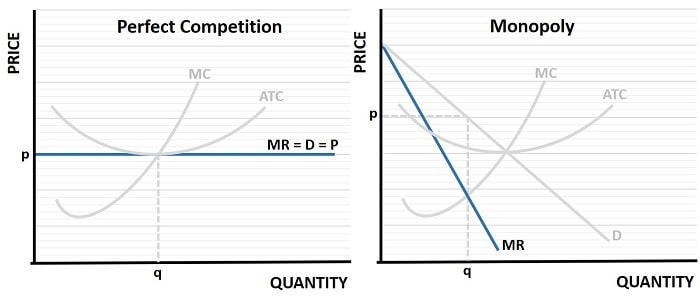- Home
- Perfect Comp.
- Profit Maximization

Profit Maximization Explained (Formula, Graph & Examples)
Profit maximization refers to the process of identifying the most efficient level of production and pricing that yields the highest possible profit. This entails a thorough understanding of cost structures, revenue streams, and market demand dynamics.
Moreover, the concept of profit maximization involves strategic decision-making and anticipation of market movements. Businesses must evaluate and adjust their production levels, pricing strategies, and cost management continuously.
Profit maximization is not just a goal but a necessity for businesses operating in competitive markets. It serves as a driving force behind economic growth and development, influencing everything from investment decisions to employment rates. When businesses maximize their profits, they generate more funds, which can be reinvested into expanding operations, innovating products, and improving services.
This reinvestment cycle fuels economic activity and contributes to overall prosperity.
On a macroeconomic level, profit maximization impacts government policies and economic stability. Profitable businesses contribute significantly to tax revenues, which fund public services and infrastructure development. Additionally, strong corporate profits bolster investor confidence, attract foreign direct investment, and promote a healthy financial market.
Different
Approaches to Profit Maximization
Businesses can adopt various approaches to achieve profit maximization, each tailored to their unique circumstances and market conditions. One common method is cost minimization, where firms focus on reducing production and operational expenses. By streamlining processes, negotiating better supplier contracts, and adopting efficient technologies, companies can lower their costs of production, thereby increasing their profit margins.
Another approach is revenue maximization, which involves strategies to boost sales and generate higher income. This can be achieved through aggressive marketing campaigns, expanding product lines, entering new markets, or enhancing customer service. By increasing the volume of sales or commanding higher prices, businesses can drive revenue growth and, consequently, maximize profits.
Most firms adopt a balanced approach, simultaneously focusing on cost reduction and revenue enhancement. This dual strategy allows businesses to optimize both sides of the profit equation, ensuring a comprehensive approach to profit maximization.
Profit
Maximization Formula
The simple formula for profit is:
Profit = Total Revenue - Total Cost
Total revenue is derived from the price at which goods or services are sold multiplied by the quantity sold, while total cost encompasses both fixed costs and variable costs associated with production.
The Role of
Marginal Cost and Marginal Revenue
Marginal cost and marginal revenue are pivotal concepts in the pursuit of profit maximization. Marginal cost refers to the additional cost incurred from producing one more unit of a good or service. It is a critical factor in decision-making, as it helps businesses determine the optimal level of production. If the marginal cost of producing an additional unit is lower than the price at which it can be sold, the firm should increase production to maximize profit.
Conversely, marginal revenue is the additional revenue generated from selling one more unit of a good or service. To achieve profit maximization, a firm must equate marginal cost with marginal revenue. When these two metrics are balanced, the firm is operating at its most efficient level, ensuring that each unit produced contributes positively to overall profit.
The Profit
Maximization Graph
In the profit maximization graph below, the price and output level that a firm optimizes its profit is always achieved where marginal revenue curve (MR) intersects the marginal cost curve (MC). This is true whether a firm is operating in perfect competition or monopoly, or any other market structure.

Understanding the interplay between marginal cost and marginal revenue allows businesses to make informed decisions about scaling production, adjusting prices, and managing resources. It provides a framework for evaluating the profitability of incremental changes, ensuring that firms can respond swiftly to market demands and maintain optimal profit levels.
Factors
Influencing Profit Maximization Strategies
Several factors influence the strategies businesses adopt to maximize profits.
- Market structure is a primary determinant, with different competitive environments requiring distinct approaches. In monopolistic markets, firms have greater pricing power and can set higher prices to maximize profits, whereas in highly competitive markets, businesses must focus on cost efficiency and differentiation to gain an edge.
- Consumer behavior also significantly impacts profit maximization strategies. Understanding customer preferences, purchasing patterns, and price sensitivity enables firms to tailor their offerings and pricing strategies effectively. Conducting market research, analyzing data, and leveraging customer feedback are essential practices for gaining insights into consumer behavior and making informed strategic decisions.
- Technological advancements play a crucial role in shaping profit maximization strategies. Innovations in production processes, supply chain management, and data analytics can significantly reduce costs and enhance operational efficiency. Embracing technology and staying abreast of industry trends allow businesses to optimize their operations, improve product quality, and respond swiftly to market changes, thereby maximizing profits.
Real-World Profit
Maximization Examples
- Apple Inc. – through a combination of innovative product design, premium pricing, and efficient supply chain management, Apple has consistently achieved high profit margins. The company's focus on creating a strong brand identity and delivering exceptional customer experiences has further solidified its market position and profitability.
- Amazon – has leveraged economies of scale and technological advancements to maximize profits. By optimizing its logistics network, utilizing data analytics, and expanding its product offerings, Amazon has significantly reduced costs and increased revenue. The company's emphasis on customer satisfaction and continuous innovation has also contributed to its sustained profitability and market dominance.
- Toyota – has demonstrated successful profit maximization through its lean manufacturing principles. By implementing just-in-time production, continuous improvement, and waste reduction strategies, Toyota has achieved significant cost savings and operational efficiency. These practices have enabled the company to maintain competitive pricing, enhance product quality, and maximize profits over the long term.
Limitations
and Misaligned Incentives
While profit maximization is a central objective in economic theory, several real-world limitations can hinder a firm's ability to achieve this ideal. One significant constraint arises from the misalignment of incentives between a company's owners (shareholders) and its management team – a phenomenon known as the principal-agent problem.
In theory, managers are appointed to act in the best interests of shareholders by making decisions that maximize profits. However, in practice, managers may pursue goals that benefit themselves rather than the firm. These may include prioritizing job security, expanding the business unnecessarily to increase their own power and prestige, or focusing on short-term earnings to trigger performance-based bonuses – all of which may diverge from long-term profit maximization.
This misalignment is exacerbated by information asymmetry, where managers possess more detailed knowledge of the firm's operations than owners do. This gap makes it difficult for shareholders to monitor managerial behavior closely and ensure that decisions align with the firm's financial objectives. Additionally, differences in risk preferences may arise: shareholders can diversify their investments and may prefer riskier, high-return strategies, while managers, whose income and reputation are tied to a single firm, tend to act more conservatively.
To address these challenges, firms often implement governance mechanisms such as performance-based compensation, regular financial disclosures, oversight by boards of directors, and shareholder voting rights. These tools are designed to align managerial behavior with shareholder interests, but they are not foolproof. The effectiveness of such mechanisms can vary widely depending on organizational culture, legal frameworks, and industry norms.
FAQs
How does profit maximization differ between short-run and
long-run decision-making?
How does profit maximization differ between short-run and long-run decision-making?
In the short run, firms may face fixed inputs and capacity limits, so profit maximization focuses on variable cost management. In the long run, all inputs are adjustable, allowing firms to rethink scale, enter/exit markets, or adopt new technologies for sustainable profitability.
Can profit maximization lead to negative externalities in
the economy?
Can profit maximization lead to negative externalities in the economy?
Yes, firms focused solely on profit maximization may overlook social costs, such as pollution or labor exploitation, leading to negative externalities. This is why regulatory frameworks and corporate social responsibility initiatives are essential.
What is the relationship between profit maximization and
shareholder value?
What is the relationship between profit maximization and shareholder value?
While profit maximization contributes to shareholder value, the two are not identical. Shareholder value also includes long-term growth, risk mitigation, and reputation management. A narrow focus on short-term profit can undermine broader shareholder interests.
How does behavioral
economics challenge traditional profit maximization models?
How does behavioral
economics challenge traditional profit maximization models?
Behavioral economics suggests that firms and consumers don't always act rationally. Managers may be influenced by cognitive biases, and consumers by emotions, introducing inefficiencies that diverge from the idealized profit-maximizing model.
How does profit
maximization differ in service-based businesses versus product-based
businesses?
How does profit
maximization differ in service-based businesses versus product-based
businesses?
Service businesses often have lower variable costs and focus more on labor efficiency and customer experience, while product-based firms emphasize supply chains and inventory management. The metrics and levers for profit differ accordingly.
What’s the difference
between accounting profit and economic profit in the context of profit
maximization?
What’s the difference
between accounting profit and economic profit in the context of profit
maximization?
Accounting profit considers only explicit costs, while economic profit includes both explicit and implicit (opportunity) costs. A firm may appear profitable on paper but not be truly maximizing economic value if opportunity costs are ignored.
Conclusion
Profit maximization remains a cornerstone of business strategy and economic theory, offering a clear objective for firms operating in competitive markets. However, as this article has explored, achieving maximum profitability involves more than simply increasing revenue or cutting costs—it requires a deep understanding of market conditions, consumer behavior, internal efficiency, and organizational dynamics. Moreover, limitations such as misaligned incentives and managerial discretion highlight the complexities that firms face in practice.
Ultimately, successful profit maximization demands a balanced, adaptive, and strategic approach. Businesses that can navigate these challenges while remaining aligned with long-term goals are better positioned to sustain profitability, drive innovation, and contribute meaningfully to economic growth.
Related Pages:
- Consumer Behavior
- Long-Run Average Cost Curve
- Economic Profit vs Accounting Profit
- Thinking At The Margin
- Deadweight Loss
- Market Equilibrium
About the Author
Steve Bain is an economics writer and analyst with a BSc in Economics and experience in regional economic development for UK local government agencies. He explains economic theory and policy through clear, accessible writing informed by both academic training and real-world work.
Read Steve’s full bio
Recent Articles
-
U.S. Industrial Policy & The Unfortunate Sacrifice that Must be Made
Dec 12, 25 03:03 AM
U.S. Industrial Policy now demands a costly tradeoff, forcing America to rebuild its industry while sacrificing bond values, pensions, and the cost of living. -
The Global Currency Reset and the End of Monetary Illusion
Dec 07, 25 03:48 AM
The global currency reset is coming. Learn why debt, inflation, and history’s warnings point to a looming transformation of the world’s financial system. -
Energy Economics and the Slow Unraveling of the Modern West
Dec 06, 25 05:18 AM
Energy economics is reshaping global power as the West faces decline. Explore how energy, geopolitics, and resource realities drive the unfolding crisis. -
Our Awful Managed Economy; is Capitalism Dead in the U.S.?
Dec 05, 25 07:07 AM
An Austrian analysis of America’s managed economy, EB Tucker’s warning, and how decades of intervention have left fragile bubbles poised for a severe reckoning. -
The Looming Global Debt Crisis – According to Matthew Piepenburg
Dec 04, 25 02:38 PM
A deep analysis of the unfolding global debt crisis, rising systemic risks, and the coming reckoning for bonds, stocks, real estate, and the dollar.